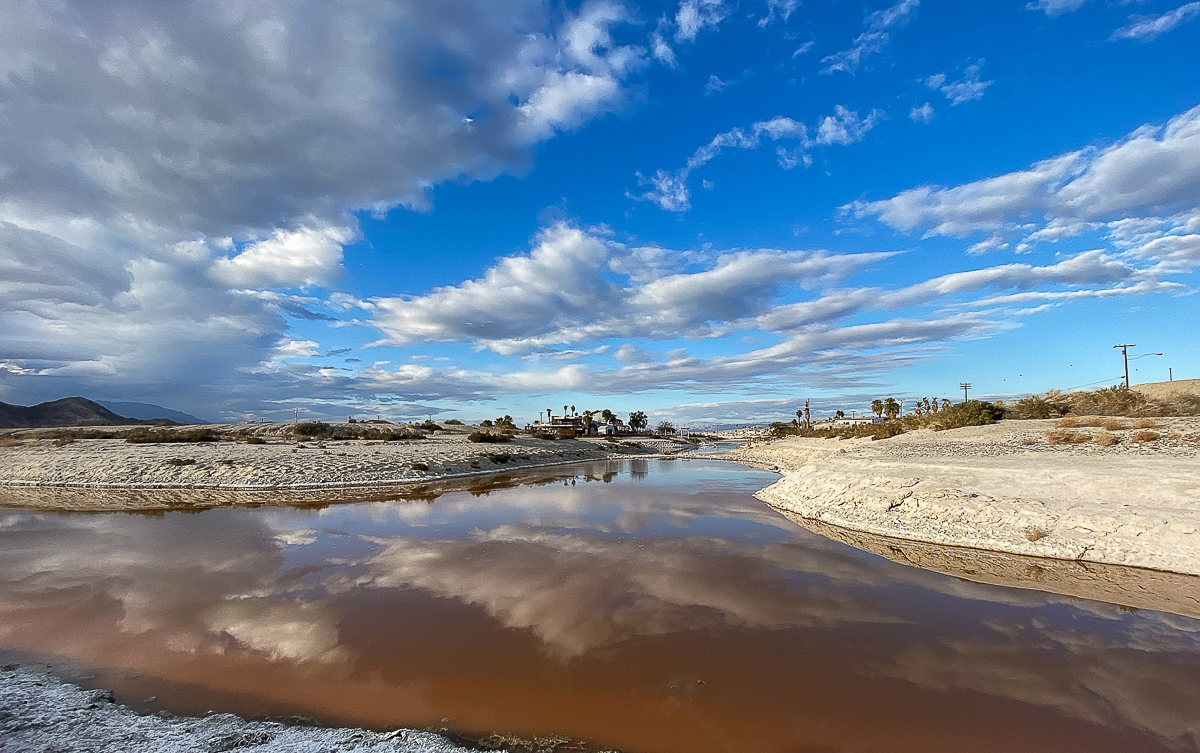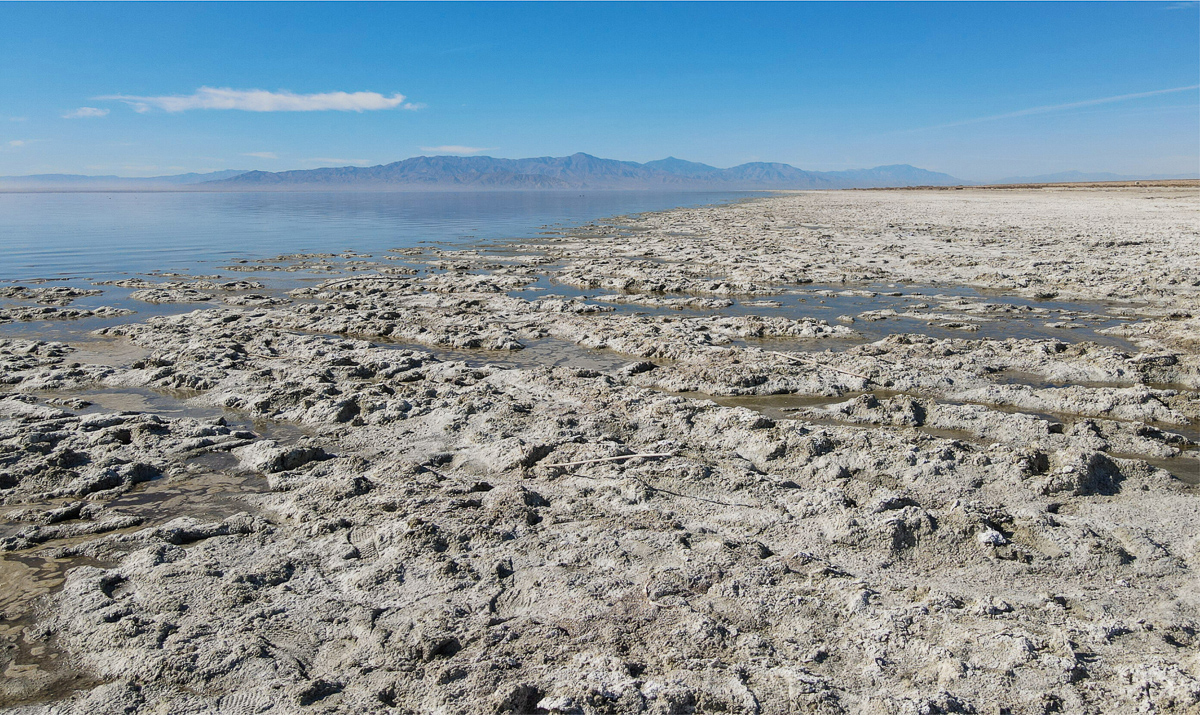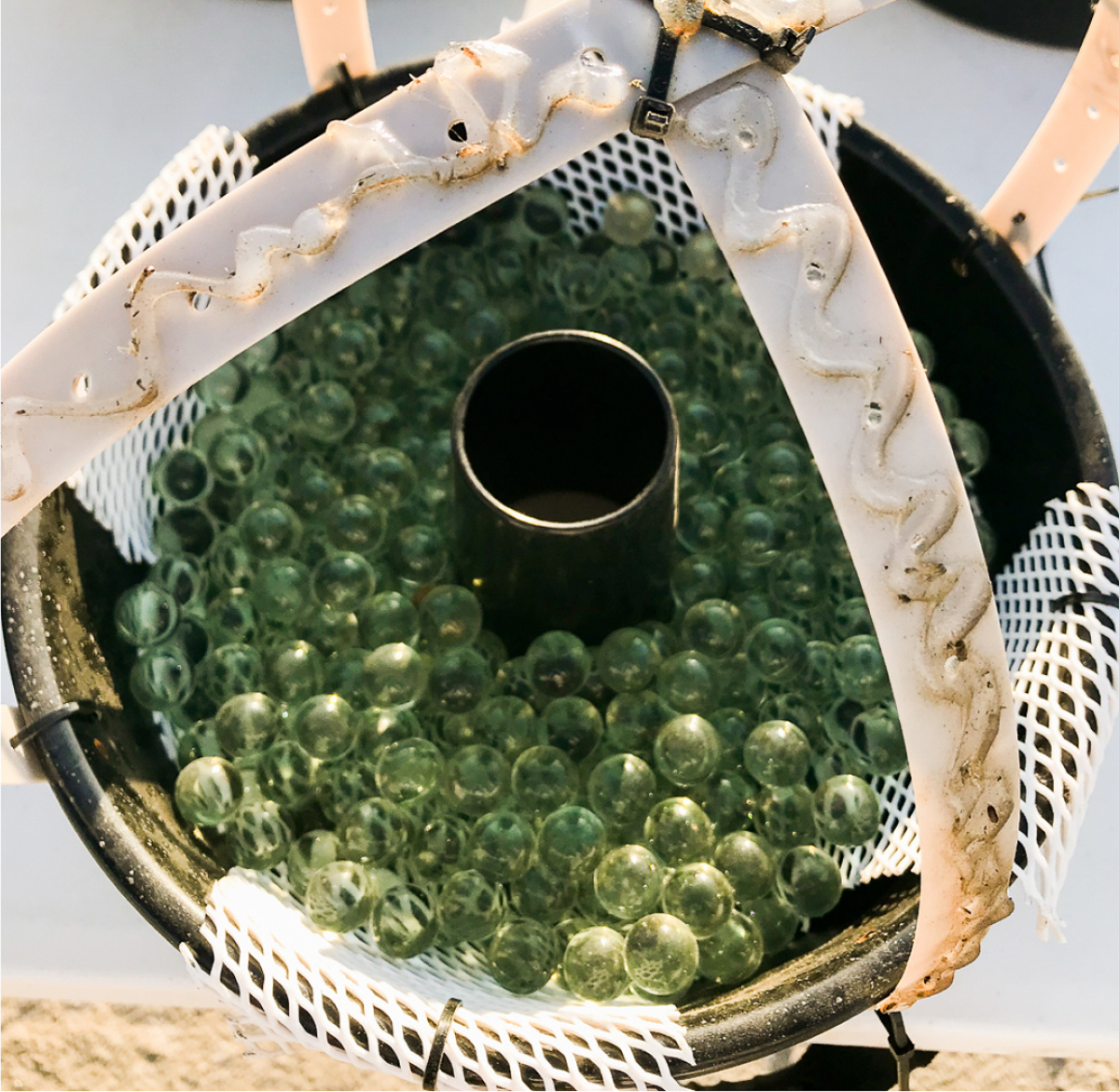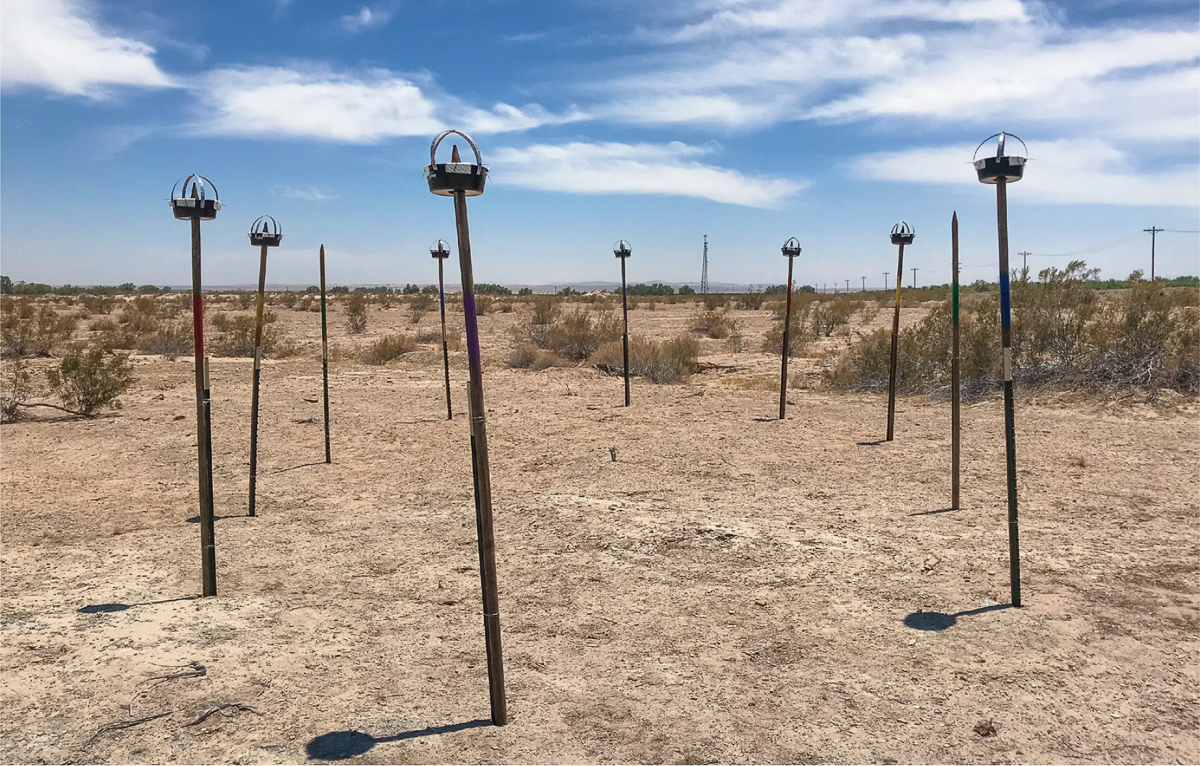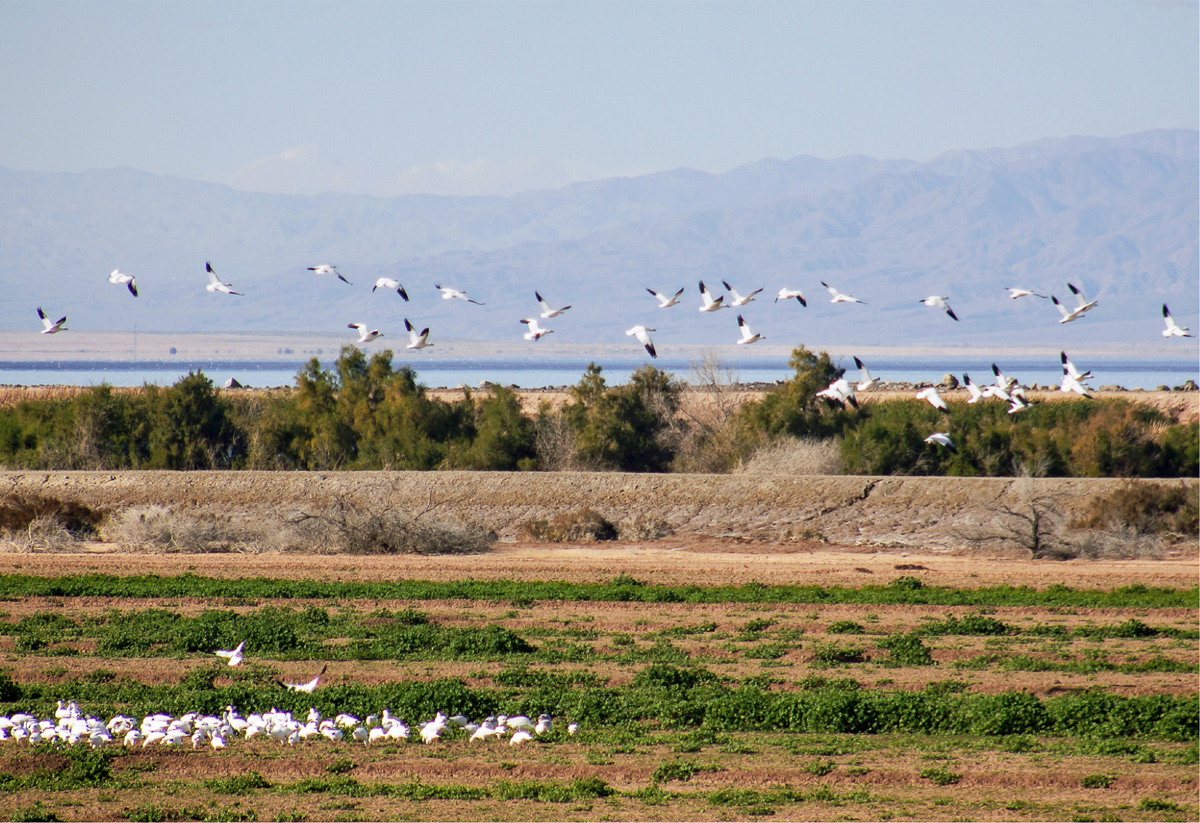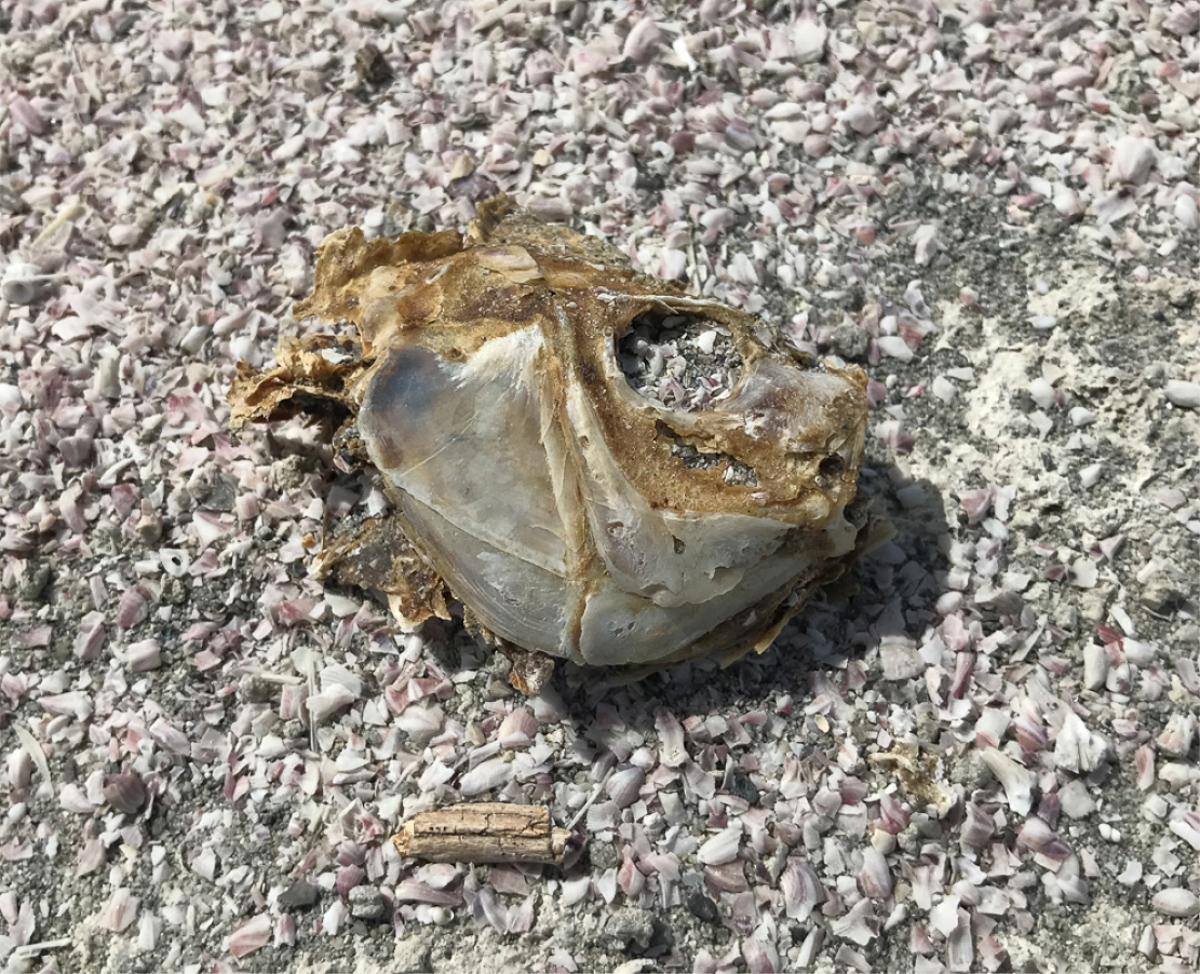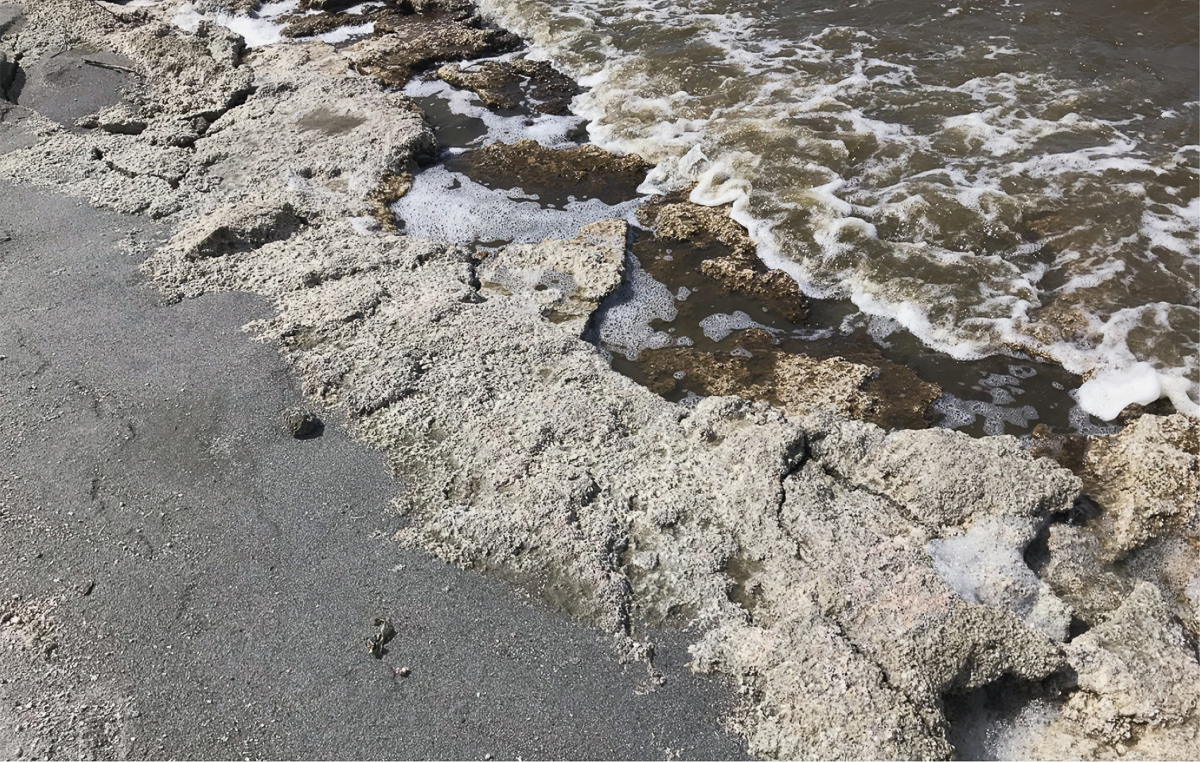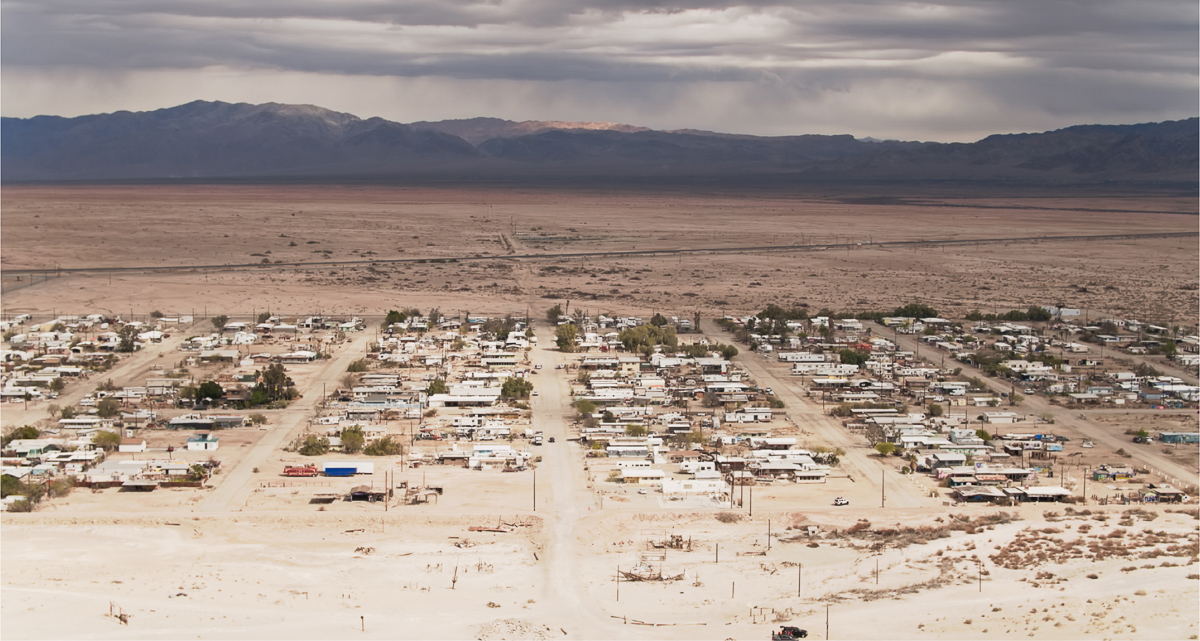All Issues
The drying Salton Sea and asthma: A perspective on a “natural” disaster
Publication Information
California Agriculture 76(1):27-36. https://doi.org/10.3733/ca.2022a0003
Published online April 22, 2022
PDF | Citation | Permissions
Abstract
The Salton Sea is a drying salt lake in an arid region with high aerosol particulate-matter concentrations. This region is plagued by a high incidence of asthma, attributed in part to the aerosols surrounding the Sea. But the connection between the Sea and asthma may be more than simple calculations of dust concentrations. While dusts might contain toxic substances that impact the lungs of residents, the complex dynamics related to the environmental degradation of the Salton Sea may be generating additional toxins relevant to public health, such as microcystins produced by algal blooms. This collection of pollutants may be driving inflammatory responses in the lungs of residents through multiple mechanisms. As such, examination of the full range of potential environmental triggers of lung inflammation promises to yield a better understanding of key mechanisms driving the high incidence of asthma in local residents. Our discussion provides a perspective aiming to re-frame the issue in the context of the historical theory of “miasma” and the linkages between environmental change and health impacts.
Full text
In modern times, we tend to think of the urban environment as a place of filth, decay and disease. The concentration of people, industry and vehicles is associated with contamination, pollution, stress and malaise. There is of course considerable history and epidemiology to support this view, and we accept this as the price we pay for “civilization.” In the context of human diseases, we link these environments with pulmonary diseases such as asthma and tuberculosis. By contrast, we tend to view the rural wild outdoors as a cleaner, healthier and more “natural” environment. But it was not always so.
Inner canals in the Desert Shore community are rapidly drying and now harbor halophilic bacteria, which makes the brine appear red. As the Salton Sea continues to shrink due to climate change and water transfers, more exposed lakebed will appear, exacerbating dust production with corresponding effects on air quality. Photo: Caroline Hung.
During the 18th and 19th centuries, miasma theory developed as a way to explain the origin and propagation of diseases such as cholera, yellow fever and malaria. The theory posited that the cause of disease was miasma, an ill-defined emanation from rotting organic matter. The theory grew from the observation that the prevalence of malaria and yellow fever was primarily in marshy regions. According to the basic miasma theory, organic matter decays and gives rise to noxious vapor —miasma — which, when inhaled, leads to sickness. The details and severity of these diseases depended on various criteria, some external, like elevation, overcrowding or environmental factors (season, humidity, barometric pressure, wind, etc.), and others internal, such as nutrition, personal hygiene or constitution (Tulodziecki 2016).
We now recognize today that these diseases are caused by pathogenic microbes, and that the germ theory of disease explains their origins. But miasma theory may yet provide a useful framework for studying diseases that arise from environmental hazards or as a context for understanding non-medical disease factors that we now refer to as social determinants of health.
Consistent with this framework, miasma-generated disease was not explicitly considered a transmissible contagion, that is, the disease could be passed on without contact with a previously sick individual. Instead, under the right circumstances, healthy bodies could “generate” their own miasma disease poison. In this way, miasma theory bore a resemblance to the theory of spontaneous generation of life. Miasma poisons were thought to be derived from environmental pollution in the form of decomposing organic matter (especially sewage and decaying animal flesh), exacerbated by conducive meteorological conditions and other factors, such as overcrowding and lack of ventilation (Tulodziecki 2016). These diseases were tied closely to certain localities, regions and seasons and, notably, could be contracted more than once. While not everyone agreed on the particulars of how the miasma diseases were generated and transmitted, most everyone agreed that the atmosphere played a significant role.
In this respect, miasma theory has striking resonance with the high incidence of asthma among residents living near the Salton Sea. Asthma in this region has reached a crisis; upwards of 20% of children living here have asthma, compared to less than 10% of children across the state (Johnston 2019). Accordingly, what follows is a perspective on the air quality near the Salton Sea as the drying Sea continues to retreat, leaving a rapidly changing saline ecology, increased aerosolized dusts and as yet poorly understood impacts on the health of residents in the region (Biddle et al. 2021). To be clear, this is not a revival of the old theory but instead an updating of the framework to incorporate modern scientific explanations of how environmental decay can lead to negative consequences for human health.
By 2029, the playa is predicted to occupy an area of approximately 145 square miles, with the PM10 emitted from exposed shorelines accounting for about 12% of total PM10 mass. Photo: Can Stock Photo / bonandbon
Local air quality
The Salton Sea region experiences high dust levels in the ambient air, a problem the region shares with other areas around the world that are proximate to dry lake beds. The Salton Basin is a closed topographic depression. This type of geologic feature is widespread and may account for 30% of all dust emissions globally (Engelstaedter et al. 2003; Ginoux et al. 2012). According to data from the five air-quality monitoring stations in the Salton Basin, the long-term mean concentrations of airborne particulate matter 10 microns or smaller (PM10) ranged from 25 to 50 micrograms per cubic meter (ug/m3) between 2015 and 2018, exceeding the California annual average allowable limit of 20 ug/m3 (CARB 2014). Dust storms, which commonly occur in the Salton Sea region, create extreme dust concentrations. A study of 10 large dust-storm events in the Salton Basin during 2015–2018 found hourly averaged PM10 concentrations to be 582 ug/m3 during storm events (Evan 2019).
As the Salton Sea continues to shrink due to climate change and water transfers, more exposed lakebed will appear, exacerbating dust production with corresponding effects on air quality. At the current time, the exposed lakebed, also known as playa, is estimated to contribute up to 9% of the PM10 mass in the Salton Sea area, compared to 45% from the surrounding desert (Frie et al. 2017). By 2029, the playa is predicted to occupy an area of approximately 145 square miles (equivalent to 38.6% of the lake area as it was in 2003), with the PM10 emitted from exposed shorelines accounting for about 12% of total PM10 mass (Parajuli and Zender 2018). While simple extrapolation predicts increasing PM10 concentration in the Salton Sea area as more lakebed is exposed, the geographic distribution of the major sources of playa dust is less clear. One study suggests that newly exposed playa emissions will emanate more from the southwest side of the lake than from the southeast side (Parajuli and Zender 2018), while a salt mineralogy study suggests that irregular “puffy” crusts formed on the southeast shoreline will result in decreased cohesiveness and higher PM10 emissions (Buck et al. 2011).
Desert dust, geochemical features
The observed health effects in the region may suggest geochemical features in common with other desert environments, but also some features unique to the Salton Sea. In a general sense, exposure to inert components of desert dust alone may be sufficient to have health effects. In the Salton Sea area, the ambient PM10 mass released from the desert is composed primarily of silica and can spread widely during natural events, such as dust storms, or through human action, such as tilling fields while farming. Silica has been shown to cause chronic bronchitis when inhaled over a long period of time, and it can even cause pneumoconiosis (Schenker 2000).
Epidemiologic studies on dust health effects are a mixed bag. Studies of dust that reaches Europe from Saharan storms suggest that any association of dust-like PM2.5 (particulate matter 2.5 microns or smaller) with daily mortality is not statistically significant (Karanasiou et al. 2012). However, one study showed that a daily increase of 10 ug/m3 in PM2.5 in Barcelona during Saharan dust storm days was associated with increased daily mortality of 5.0%, compared with 3.5% during non-Saharan dust storm days (Perez et al. 2008). Dusts and acute respiratory symptoms do show some predictable associations; one study on short-term effects of PM10 on pediatric asthma emergency admissions in Athens, Greece, found that a 10 ug/m3 increase in PM10 was associated with a 2.54% increase in the number of pediatric asthma hospital admissions (Samoli et al. 2011).
The Salton Sea Basin also contains some geochemical features unique to the region, and these features may produce toxic components with health impacts beyond those associated with the simple physical presence of desert and playa dust particles. For example, in addition to dust emissions from the exposed playa, the geochemistry of the Sea itself contributes aerosol components to the atmosphere, notably ammonia. The decaying anoxic (oxygen depleted) ecosystem in the Salton Sea has been estimated to release 5,700 megagrams of ammonia into the atmosphere each year (Amrhein et al. 2005). Additionally, geothermal vents associated with a hydrothermally active fault traversing the southeast margin of the Salton Sea emit substantial amounts of free ammonia to the atmosphere due to pyrolytic decomposition of agricultural runoff and plant matter (Tratt et al. 2011). Ammonia is corrosive and causes coughing; even at low concentrations it can cause nose and throat irritations. Atmospheric ammonia is also involved in atmospheric photooxidation reactions, which are highly associated with secondary aerosols (Pinder et al. 2008).
Sulfate enrichment in the Salton Sea playa soil could potentially exacerbate the effect of pollen on people with allergic asthma. One recent study found a high mass fraction of soluble sulfate (∼29%) in Salton Sea playa, indicating that Mg-sulfate and Ca-sulfate minerals may be important components of the playa emissions. Moreover, sulfuric acid may potentiate the early asthmatic response of mild asthmatic subjects to pollen allergen (Frie et al. 2019; Tunnicliffe et al. 2001).
Agricultural PM sources
The Salton Sea region supports an agriculture economy that depends on irrigation from the Colorado River, whose runoff is critical to the maintenance of the Sea. This activity also contributes to the aerosols surrounding the Sea; beyond the effects of toxic chemicals in the air from the local geochemistry, particulate matter and bioaerosols from the agricultural activity in the region also may deliver components with potential health effects on both agricultural workers and nearby residents (Radon et al. 2004).
In general, biological material derived from animals, microbes and plants may contribute significant bioactive materials to the atmosphere. For reference, personal exposure concentrations for PM2.5, inhalable PM and microbial endotoxin for California dairy workers (not specific to the Salton Sea region) were reported to be 48 ug/m3, 987 ug/m3 and 453 endotoxin units per m3, respectively (Garcia et al. 2013). Studies have shown that occupational exposure to PM at such levels is associated with changes in pulmonary function and may cause chronic obstructive pulmonary disease, organic dust toxic syndrome, bronchitis, pneumoconiosis, rhinitis or asthma (Heederik et al. 1994; Malmberg 1990; Monsó et al. 2004; Schenker et al. 2005). While dairy and swine activity is not prominent in the Salton Sea region, dust exposure from this type of farming around the world has been reported to be directly associated with symptoms such as wheezing, coughing and phlegm production (Dosman et al. 1987; Zejda et al. 1993).
Unfortunately, while interpretation of disease prevalence differences can be difficult due to differences in multiple factors (see “Confounding factors” below), California and Europe appear to share similarities in the impact of agricultural activities on asthma incidence (Malmberg 1990; Schenker et al. 2005). Differences in exposure type and level due to various atmospheric contaminant sources may therefore become significant factors for future consideration.
Because seasonal crops are the main agriculture activity in the region, one potential factor contributing to pulmonary disease is the use of pesticides. Recent studies have detected 14 different pesticides in runoff water at the Salton Sea (LeBlanc and Kuivila 2008). The health impacts of pesticides are known to some degree; long-term bipyridilium-class herbicides, for example, have been shown to cause a decrease in mid-expiratory flow rate (forced expiratory flow, or FEF25-75), which can indicate bronchial hyperreactivity, a component of asthma-like diseases (Hernández et al. 2008). Another herbicide, chlorimuron-ethyl, has been shown to cause an increase in the odds risk of wheezing among pesticide applicators (Hoppin et al. 2006). Phenoxy compounds in pesticides were also shown to be associated with an increase in asthma and wheeze among grain farmers depending on the number of years exposed (Cherry et al. 2018). Organophosphates, used as insecticides, have been shown to cause both an increase in wheezing among adults with long-term exposure (Hoppin et al. 2006) and a decrease in FEV1 (forced expiratory volume in first second), FVC (forced vital capacity) and FEF25-75 in 7-year-olds who have been exposed to low-level doses, indicating lung dysfunction (Raanan et al. 2016).
Unfortunately, while agricuture-generated dusts and the potential exposure to pesticides might contribute a unique combination of toxic components to the aerosols in the Salton Sea region, it is not known whether the levels of these chemicals are high enough to affect pulmonary health. The range of agricultural activities at the northern and southern ends of the Sea may have different contributions to the environmental effects, but here too we do not have information on health effects unique to one location versus another.
Pollen
In addition to agricultural sources of plant-derived biologically active materials, other airborne biologically active plant sources, notably pollens, can come from both indigenous wild plants and invasive plant species in the desert environment surrounding the Salton Sea. While these wild areas are subject to changes associated with chronic drought and increasing temperatures, it is not known whether the changing environment contributes to health impacts from components generated at the Sea itself. However, the presence of pollen does set the stage for exposures to an array of environmental allergens, including indoor household allergens. Pollen can cause pollinosis (hay fever) and has been linked to asthma incidence (Taylor et al. 2007). Pollen grains are typically large, ranging from 15 um to 200 um. Although many intact pollen grains are too large to penetrate the small airways where asthma occurs, pollen cytoplasmic fragments can be respired into the lungs and are likely correlated with the asthmatic response in allergic asthmatics. Pollen has also been studied with other typical urban PMs, such as diesel exhaust particles, for possible synergistic effects. One theory suggests that these other PMs actually work as carriers for pollen allergens (Taylor et al. 2007).
Ecosystem degradation
While the combination of a desert environment and agricultural activity could be sufficient to affect health, they might not be sufficient to explain the high rates of asthma in the Salton Sea region. However, the ongoing changes associated with the Sea may be generating other, perhaps greater, contributing factors, especially those produced by ecosystem degradation combined with dust emissions at exposed playa.
In the 20th century, the Salton Sea was a productive and diverse tourist destination, serving as both a recreational hub and a vital habitat for avian populations (Setmire et al. 1993). With ongoing evaporation and redirection of freshwater inputs (Tompson 2016), however, water levels have declined, salinity levels have increased, and greater playa area is exposed. Coupled with increased temperatures and prevailing drought, rising salinity levels and increased dust emissions detrimentally impact the regional ecology. Among those most affected are migratory birds, juvenile fish (Kuperman et al. 2001) and marine crustaceans (Upadhyay et al. 2018), all of which increasingly suffer mortalities, hepatotoxicity and damage from microbial proliferation. Indeed, bacterial pathogens and ectoparasites exploit environmental niches and can potentially infect nearly all of the wildlife. Given the hypersaline status of the Sea, halophilic microbes, including cyanobacteria, proliferate (Hawley et al. 2014). These organisms produce toxins that bioaccumulate, causing acute-to-lethal toxicity in birds, such as the eared grebe (Podiceps nigricollis; Carmichael and Li 2006).
Eco-epidemiologal models show that increased hypersalinity and playa dust in the Salton Sea region are driving bird and fish populations to extinction or extirpation. Photo: Jonathan Nye
Predator-prey dynamics within the drying Salton Sea basin exacerbate the decline in vertebrate populations dwelling within this unstable ecosystem, as massive rates of die-off ensue. Over time, the migratory birds that consumed infected fish suffered great losses, which was compounded as their diets shifted to feeding almost exclusively on invertebrates (Bradley and Yanega 2018). These invertebrates often harbor pathogens and dinoflagellates. Eco-epidemiological models of this novel ecosystem (Chattopadhyay and Bairagi 2001; Upadhyay et al. 2018) show that the region's unstable ecology has been forced into chaotic dynamics, as increased hypersalinity and playa dust are driving bird and fish populations to extinction or extirpation. Overall, this drying lakebed heavily impacts the ecological systems that rely on the Salton Sea.
Juvenile fish, migratory birds and marine crustaceans increasingly suffer mortalities and hepatotoxicity from microbial proliferation at the Salton Sea. Photo: David Lo.
Exactly how the instability and degradation of the Salton Sea region contribute to the air quality and hence pulmonary health of its human residents is poorly understood, but it is known that ecological instability stresses resident microbes (Freund et al. 2022), which can result in the production of toxins, such as those that cause algal red tides. Onshore winds and breaking surf promote the release of the toxins into the onshore aerosol. This happens when, for example, the hypersaline cyanobacteria in the Sea undergo periodic algal blooms and produce toxins called cyanotoxins, namely microcystins, such as microcystin-LR and microcystin-YR (Carmichael and Li 2006). The high levels of selenium in the Salton Sea, derived from contamination from surrounding rocks as well as from mining and agricultural operations, can increase the microcystins produced by the alga, and these toxins can be released due to the hypersaline conditions of the Sea (Zhou et al. 2017). Microcystins have been shown to cause alveolar thickening in human lungs and an increase in inflammatory cytokines, which causes lung dysfunction (Li et al. 2016). Cyanobacteria and microcystins have even been detected in desert soils (Metcalf et al. 2012), which could contribute to a baseline level of exposure even when the Sea is not having an active algal bloom. Additional work is needed to test whether these microbial factors are present in significant amounts in both desert and playa dust before we can consider any potential roles they may play in local health effects.
Playa crusts at the North Shore of the Salton Sea. As water levels have declined, salinity levels have increased, and greater playa area is exposed. Photo: David Lo.
Which asthma?
The discussion to this point has covered diverse local sources of aerosols, from agricultural activity to pollen to ecological changes in the Salton Sea. Thus, the stage is set for understanding how the Sea's changing environment affects pulmonary health. Within our proposed miasma framework, the environmental and ecosystem degradation at the Salton Sea parallels the original notion of organic decay, producing vapors (in this case, aerosols) that drive a specific pattern of pulmonary disease.
A detailed discussion of clinical asthma may be useful as, of course, miasma is not listed among contemporary medical practice differential diagnoses. Most people associate common asthma with allergic disease, but in fact clinical asthma is only defined as airway hyper-reactivity (increased airflow resistance in response to triggers such as dust, allergens or other stimulus). Asthma is not strictly dependent on allergic inflammation or specific allergen triggers (Godfrey 1985). Except for pollen, the aerosol components with lung toxicity or airway irritant activity described in this article are not allergens, and so we need to clarify different ways in which non-allergic asthma-like symptoms can be induced.
First, acute airway hyper-reactivity may occur in response to a dust exposure, such as in a dust storm, or by occupational exposure to industrial dusts. This may be mediated by irritant receptors in the lungs, including those present on specific nerve fibers called c-fibers (Rogerio et al. 2011), which drive intrinsic physiological responses to the irritants. These responses may be limited to acute events with no long-term consequences. A second broad category of non-allergen-induced asthma includes those associated with chronic lung conditions in people with increased susceptibility to airway hyper-reactivity. While this category can include asthmas induced by allergic inflammation, it also includes asthmas caused by chronic occupational dust exposures. The third category of non-allergen-induced asthmas include asthmas caused by inhalation of microbial components or by bacterial infections.
The asthmas in all three of the categories described above can produce symptoms in the absence of an allergen or allergic response. Thus, different clinical phenotypes may be present that all fall under the general diagnosis of asthma. At one end of the spectrum is classic, or atopic, allergen-induced inflammation, associated with eosinophil (a specialized white blood cell) infiltration and a characteristic set of allergy-associated cytokines. At the other end of the spectrum are those asthmas caused by non-allergic inflammatory triggers. These triggers may lead to an inflammatory response involving predominantly neutrophils, a different set of white blood cells from those involved in allergen-induced responses, and a different set of induced cytokines (Douwes et al. 2002). In the context of the present discussion, we consider the possibility that exposures to the environment around the Salton Sea may provoke pulmonary inflammation and a clinical picture that might not be strictly limited to classic allergic asthma. But to be clear, it does not rule out the possibility that allergic disease can also be present, and may in some cases exacerbate airway hyper-reactivity from other causes.
Mechanisms for exposure
Our discussion extends the potential range of asthma triggers beyond, though not excluding, allergic disease, so that the notion of an environmental miasma can refocus the search for disease mechanisms and the environmental sources of disease triggers. That is, we can consider ways in which non-allergic triggers may be provided by environmental aerosols. From a clinical perspective, this miasmic interpretation may also change our understanding of the asthma-like symptoms among residents in the Salton Sea region.
Aerial drone still of Bombay Beach off the shores of the Salton Sea in Imperial County, California. As the Salton Sea continues to shrink due to climate change and water transfers, more exposed lakebed will appear, exacerbating dust production with corresponding effects on air quality in the region. Photo: Hal Bergman / iStock
Allergic inflammation in response to specific allergens is primarily mediated by soluble biological mediators called cytokines categorized under what is called the Th2-dependent type of immune response. In this response, the immune system focuses on specific antigens, or allergens; here, long-lived inflammatory cells of the immune system, such as T lymphocytes, provide the cytokines but also carry long-lived memory of the allergen, so that re-encounter or persistent exposure to the same allergen leads to amplified inflammatory responses. This memory response is characteristic of what immunologists refer to as adaptive immunity. This is distinguished from innate immunity, which relies on the responses of a different set of inflammatory cells, such as neutrophils, which provide rapid and short-lived responses but carry no memory of the encounter. Innate immune responses are characteristically induced by microbial components, including endotoxins and bacterial cell walls as well as some virus components. Thus, these different types of immune responses and associated inflammations may drive different types of asthmatic disease, depending on the trigger.
In the context of lung inflammation, allergic (adaptive) immunity also includes a characteristic pathological picture of recruitment and activation of eosinophils in the airways following exposure to an allergen (Lloyd and Saglani 2015). In contrast, neutrophil inflammation is associated with both allergic and non-allergic asthma (Douwes et al. 2002; Seys et al. 2019). The distinction between these different types of inflammation may help provide important clues as to the types of environmental components driving pulmonary disease. They also may help identify links between the ecosystem changes in the Salton Sea region and the consequent health effects.
The receptors, signaling pathways and patterns of gene expression involved in the immune system's innate and adaptive responses to activating triggers vary widely. For example, protein complexes known as inflammasomes are activated by specific microbial components (e.g., endotoxin, microbial toxins). These microbial components, while often not intrinsically toxic themselves, are harbingers of infection and thus represent “danger signals” to the immune system (Hosseinian et al. 2015). The responses of different inflammasome complexes and related signaling molecules provide characteristic clues both to the environmental trigger and to the lung inflammatory response. Thus, by identifying the patterns of response to environmental exposures, we can seek to identify characteristic patterns, or “fingerprints,” of responses that are specific to each type of trigger. Importantly, this can also provide information on the characteristics of the lung inflammatory disease that is induced; these characteristics may be critical in distinguishing between an allergic (adaptive) inflammation and a non-allergic (innate) response. The difference between these two responses is important not only in identifying critical environmental triggers, but also in understanding the inflammatory disease and associated asthma-like symptoms discussed above so that the correct diagnosis and clinical treatment can be applied.
Confounding factors
Although various aerosol dusts may trigger inflammation and contribute to the development of asthma, this disease process may be complicated by a variety of airborne factors that might actually moderate asthma symptoms. The hygiene hypothesis, for example, states that early exposure to airborne microbes may reduce the incidence of allergy and some autoimmune diseases by inducing a kind of immune system education, or regulation (Bach 2002). This hypothesis suggests a protective role for inflammasomes in diseases such as allergy and asthma; however, this protective role has to be reconciled with the proinflammatory role of the inflammasomes. Chronic exposure to aerosolized material from the Salton Sea that contains microbial toxins may overcome any protective effect and instead drive chronic inflammation and asthma.
Exposure to agricultural environmental components may also have a moderating effect on the development of asthma. For example, studies have shown that children raised on a farm tend to have fewer cases of asthma than children raised elsewhere (Ege et al. 2007). These effects seem to be modulated by the type of farming done and the animals kept, with pigs providing some protection from atopic asthma and sheep likely promoting the disease (Ege et al. 2007). Additionally, one study found that children who worked on their family farms had a higher risk for asthma than the children who lived on a farm but did not do farm work (Syamlal et al. 2018). This suggests that the protective effect of farming on childhood asthma may depend on the scale of work and the specifics of the farm, such as whether the farm is primarily crop-based or animal-based. It is not known whether crop-based agricultural activity has any similar effects. The ethnicity of the farmers also may play a role, as people of color have higher asthma rates in American farms, reflecting the trend toward higher asthma rates in people of color in the overall population (Syamlal et al. 2018).
Further confounding the protective results of farming on asthma, similar rates of asthma have been found among adults who were raised on a farm and those raised elsewhere. However, the rate of allergic disease was found to be far lower in adults raised on a farm, particularly those who primarily drank raw milk and worked with farm animals while young (House et al. 2017). Farming as an adult may increase the risk of asthma or wheezing by as much as two-fold, though this may be an underestimate due to potential self-selection via the “healthy worker effect,” wherein those who begin to experience medical hardships, such as asthma, retire or find other kinds of work and are thus no longer counted (Arif et al. 2002).
New research findings
The discussion to this point has been a consideration of environmental factors that are suspected of contributing to pulmonary disease either because of known toxicity in other settings or because of correlations between detectable levels and disease incidence. The challenge in identifying causal effects in such a complex environmental setting is that the presence of a toxin does not necessarily mean that exposure levels are high enough to have a biological effect, and low levels of chronic exposure may have effects that are difficult to directly demonstrate. Moreover, toxic components may be present that have simply not yet been identified or measured.
Thus, to develop a more direct assessment of the health impacts of aerosols in the Salton Sea region, our collaborative group has been collecting materials from the Salton Sea environment and exposing mice to the aerosols generated by them. For this purpose, in our studies we developed an environmental exposure chamber. In studies to validate the system (Peng et al. 2018), mice were continuously exposed to the aerosol of a common household fungal allergen. As a result, the mice developed a characteristic allergic inflammatory response, with both neutrophil and eosinophil recruitment into the lung and corresponding inflammatory gene induction.
With an in vivo assay for biological effects of aerosols on pulmonary inflammation, we can test whether aerosols generated from Salton Sea material induce allergic inflammation and/or asthma. We collected water directly from sites around the Sea and subjected mice to the aerosols generated from the different samples (Biddle et al. 2021). We did not detect allergic inflammation in the mice following exposure, but we did detect a novel gene expression consistent with inflammation. Follow-on studies using aerosols generated from dust collected near the Sea (Biddle et al., preliminary unpublished data) also induced inflammatory lung responses, including recruitment of neutrophils, but no eosinophils and no gene expression indicative of allergic inflammation.
By contrast, aerosols from materials we collected from sites distant from the Sea (e.g., near Palm Springs or the Pacific Ocean) did not induce lung responses. Thus, it appears that Salton Sea aerosols, whether from the water or from the dust, induce responses characteristic of inflammation, but not allergic inflammation. While some aspects of the inflammation are novel, many of the features are most consistent with innate immune responses, which could be induced by microbial toxic components or by other components not yet identified. Additional studies are needed to test any direct link to asthma, but it is suggestive that a non-allergic inflammation is induced by Salton Sea-specific components. Moreover, the evidence so far is also consistent with the notion that the degradation of the Salton Sea ecosystem provides components unique to the region that promote lung inflammatory disease. Thus, our modern framing of miasma in this region may indeed have supporting evidence from modern research methods and results, and the findings militate toward a re-evaluation of the relationship between changes at the Salton Sea and local health effects.
Regardless of how we might frame this story, much more research is needed on dissecting the connection between the Salton Sea and pulmonary health in nearby communities. Most approaches toward mitigation have focused on the usual suspects, related only toward the engineering aspects of dust production at the playa. The framing of the health risks as a contemporary version of environmental miasma may help direct resources toward research on ecosystem dynamics as a primary factor in community health impacts. While this reframing is likely to complicate mitigation efforts, it will also promote more integrated analysis of the dynamics of the region and may lead to more sustainable strategies.
Coda: A new miasma framework
Superseded by current germ theory, the miasma theory of illness is now seen as an outdated way of looking at epidemiology. Miasma theory, as commonly understood, was a way to direct attention toward the local ecology to explain the origin and propagation of some epidemic diseases. Early miasma theory may have been superseded by modern germ theory, but bad odors and polluted air persist today. The perspective presented here is aimed at providing a new rationale for updating miasma theory and a context for considering its impact in affected communities. This includes consideration of the Salton Sea communities themselves. The high incidence of asthma in the region largely affects persons of color, many of whom have lower socioeconomic status and live in medically underserved areas. While health disparities might be too easily attributed to these kinds of proximate social determinants, it might instead be more logically explained by a series of consequences: low-income, affordable housing in a limited geographical range followed by exposure to toxic aerosols produced as a consequence of environmental degradation. With modern scientific approaches to the biology of asthma in the Salton Sea region, including closer study of the toxic aerosols produced near and from the Sea, we can now re-examine the relationship of its residents to their environment and re-frame the concept of miasma as a matter of environmental degradation with consequences for communities independent of their social status.



